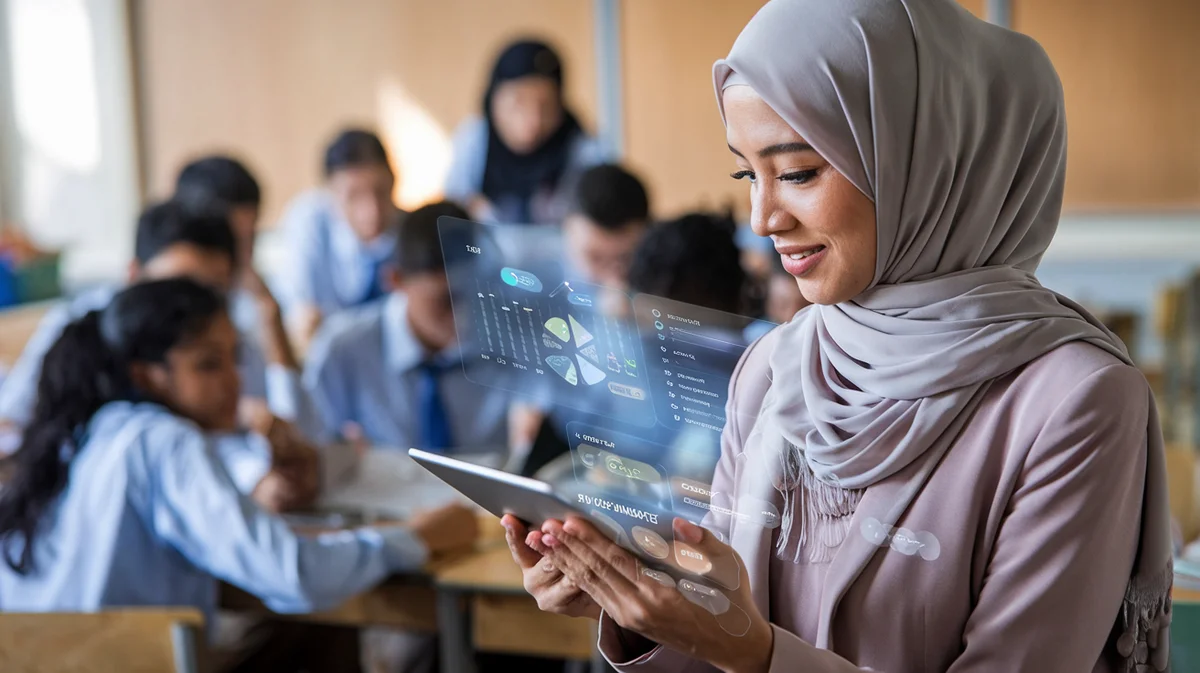Inclusive AI in Education: Empowering Every Learner


wp:paragraph
Artificial intelligence is rapidly transforming classrooms worldwide. At UNOWA, we believe that inclusive AI in education is not just a technological upgrade — it's a moral imperative. Our mission is to ensure that every learner, regardless of background or ability, benefits from the promise of AI-powered learning. Here’s how we’re shaping the future of education for all.
/wp:paragraph
wp:heading {"level":2}
The Global Push for Inclusive AI in Education
/wp:heading
wp:paragraph
Across the EU, MENA, and CIS regions, governments and institutions are investing heavily in AI-driven educational solutions. The Middle East & Africa AI in education market alone was valued at $128.5 million in 2022, with a projected annual growth rate of 37.5% through 2030. In the Gulf Cooperation Council (GCC) countries, the market reached $33.6 million in 2023, reflecting a region-wide commitment to digital transformation.
/wp:paragraph
wp:paragraph
But rapid growth brings challenges. While 30% of UK students already use AI tools in school, only 31% have learned about AI from teachers, and a staggering 74% of teachers report having no AI training. This gap is echoed globally, especially in regions where digital infrastructure and teacher preparedness are still developing.
/wp:paragraph
wp:heading {"level":2}
Why Inclusive AI Matters
/wp:heading
wp:paragraph
Inclusive AI in education means more than just deploying smart technologies. It’s about designing systems that:
/wp:paragraph
wp:list
- Adapt to diverse learning needs, including those of students with disabilities and special educational needs (SEN)
- Bridge digital divides, ensuring access for rural, low-income, and marginalized communities
- Respect cultural and linguistic diversity through localized content and multilingual support
- Uphold human rights, data privacy, and ethical standards
/wp:list
wp:paragraph
The European Union’s Digital Education Action Plan, for example, prioritizes accessibility, teacher training, and ethical AI use. In the MENA region, Saudi Arabia aims to embed AI literacy in 40% of its workforce by integrating AI into educational institutions. The UAE is piloting generative AI in classrooms, while initiatives like Google’s “Maharat min Google” are working to bridge digital skills gaps for underserved communities.
/wp:paragraph
wp:heading {"level":2}
Challenges on the Path to Inclusion
/wp:heading
wp:paragraph
Despite progress, several barriers remain:
/wp:paragraph
wp:list
- Talent Shortage: Many regions, especially in MENA, face a lack of local expertise to develop and maintain AI solutions. As Langendorf & Farley (2021) note, “A common weakness across the region is the lack of talent working on AI solutions... a key policy focus is to cultivate local AI talent for an increasingly tech-dependent economy.”
- Equity and Access: Without targeted interventions, AI can exacerbate existing inequalities, leaving disadvantaged students further behind.
- Teacher Preparedness: Most teachers worldwide have not received adequate training in AI, limiting their ability to guide students safely and effectively.
- Human Rights Considerations: AI integration must address the needs of marginalized students and protect their rights.
/wp:list
wp:heading {"level":2}
Proven Strategies for Inclusive AI-Based Learning
/wp:heading
wp:paragraph
At UNOWA, our approach is grounded in global best practices and tailored to local contexts. Here’s what works:
/wp:paragraph
wp:heading {"level":3}
1. Localized Training and Content
/wp:heading
wp:paragraph
We deliver AI training and curriculum-aligned content in multiple languages, ensuring relevance and accessibility. Programs like Google’s AI Opportunity Initiative, which provides AI training in Arabic for underserved communities, demonstrate the impact of localization.
/wp:paragraph
wp:heading {"level":3}
2. Empowering Educators
/wp:heading
wp:paragraph
We invest in comprehensive teacher training and ongoing professional development. Initiatives such as the Raspberry Pi Foundation and Google DeepMind’s “Experience AI” program show that equipping teachers with AI literacy is crucial for student success.
/wp:paragraph
wp:heading {"level":3}
3. Public-Private Partnerships
/wp:heading
wp:paragraph
Collaboration is key. We work with ministries of education, international organizations like UNESCO and the World Bank, and local partners to scale AI education and ensure inclusivity. These partnerships enable us to leverage global expertise and funding for maximum impact.
/wp:paragraph
wp:heading {"level":3}
4. Inclusive Design and Co-Creation
/wp:heading
wp:paragraph
We co-design AI tools with input from teachers, students (including those with disabilities), and parents. This ensures that our solutions are user-friendly, adaptable, and effective for all learners.
/wp:paragraph
wp:heading {"level":3}
5. Robust Policies and Ethical Standards
/wp:heading
wp:paragraph
We advocate for and help develop national strategies that include clear guidelines for ethical AI use, data privacy, and inclusion. UNESCO and the World Bank offer valuable frameworks for rights-based, equitable AI integration.
/wp:paragraph
wp:heading {"level":2}
Real-World Impact: Case Studies
/wp:heading
wp:list
- Saudi Arabia: Partnered with Kazakhstan’s EdTech startup CodiPlay to introduce advanced AI technologies in 200 schools, focusing on both student and teacher AI literacy.
- UAE: Piloting generative AI in classrooms, with a focus on accessibility and teacher support.
- Google’s Arabic AI Training: In 2024, Google launched an Arabic-language AI curriculum and expanded teacher training programs in the MENA region, making AI skills more accessible and inclusive.
/wp:list
wp:heading {"level":2}
Our Commitment at UNOWA
/wp:heading
wp:paragraph
With over 15 years of experience and a portfolio spanning 300+ national projects, we are dedicated to empowering institutions, educators, and students through innovative, inclusive, and scalable solutions. Our MIKKO platform for inclusive education, Ulabs for STEM innovation, and comprehensive analytics and training services are designed to transform learning experiences and create a better world.
/wp:paragraph
wp:paragraph
We believe every child deserves access to quality education, regardless of their abilities or circumstances. By championing inclusive AI in education, we are building a future where no learner is left behind.
/wp:paragraph
wp:heading {"level":2}
Best Practices for Implementing Inclusive AI in Education
/wp:heading
wp:list
- Co-design with stakeholders: Involve teachers, students (including those with disabilities), and parents in the development of AI tools.
- Continuous assessment: Regularly evaluate the impact of AI tools on learning outcomes and equity.
- Open resources: Prioritize open educational resources and multilingual content to reach diverse learners.
- Data privacy: Implement robust data privacy and security measures in line with international standards.
/wp:list
wp:paragraph
For more on global guidelines and best practices, see:
/wp:paragraph
wp:list
- UNESCO: Artificial Intelligence in Education
- World Bank: Digital Transformation in Education
- European Commission: Digital Education Action Plan
- Google: Maharat min Google
/wp:list
wp:paragraph
Learn more about our approach and solutions at UNOWA.
/wp:paragraph
wp:heading {"level":2}
FAQ: Inclusive AI in Education
/wp:heading
wp:paragraph
What is inclusive AI in education? Inclusive AI in education refers to the use of artificial intelligence tools and systems designed to adapt to the diverse needs of all learners, including those with disabilities, from marginalized backgrounds, or with special educational needs.
/wp:paragraph
wp:paragraph
How does UNOWA ensure AI-based learning is inclusive? We co-design our platforms with input from educators, students, and parents, offer multilingual and accessible content, and provide ongoing teacher training to ensure equitable access and effective use.
/wp:paragraph
wp:paragraph
What are the main challenges in implementing inclusive AI in education? Key challenges include a shortage of local AI talent, insufficient teacher training, digital divides, and the need for robust policies to protect student rights and privacy.
/wp:paragraph
wp:paragraph
How can governments and institutions promote inclusive AI in education? By investing in teacher training, developing national AI strategies with a focus on inclusion, partnering with international organizations, and ensuring that AI tools are accessible to all students.
/wp:paragraph
wp:paragraph
Where can I learn more about UNOWA’s inclusive education solutions? Visit UNOWA’s website for detailed information on our products, services, and impact stories.
/wp:paragraph
wp:paragraph
Let’s work together to transform learning experiences for the better. Empowering educators to create a brighter future for all students — that’s our promise at UNOWA.
/wp:paragraph








